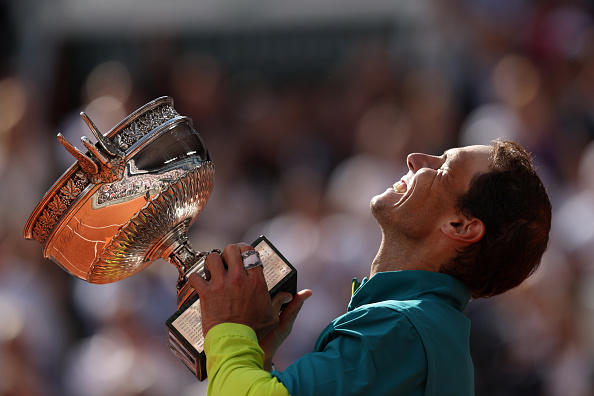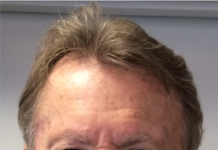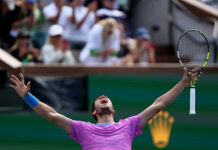Bill Simons
Paris
After beating Casper Ruud, 6-3, 6-3, 6-0, to win his 14th French Open, Rafa Nadal at last opened up about his injured foot. He revealed that he’d been getting two injections per match to “put to sleep” the nerves in his foot.
He said it was a big risk to play with a numbed foot but his passion for Roland Garros made him want to do it. “That was the only way to give myself a chance here, no? So I did it,” he said. He added that he may get radiological treatment or eventually have major surgery. He said he would love to play Wimbledon this year, but he only would do so if his body allows. He would play Wimbledon using anti-inflammatories, but not with injections that would put his foot to sleep.
He added that his happiness was the key factor in his life and he would only play in the future if tennis still brought him happiness. One asks, are there any limits to this man? The warrior athlete inspires in so many ways.
In Australia, Rafa came from behind to score a win that, in the wake of L’Affaire Djokovic, lifted the spirits of millions. Then he went undefeated until deep into Indian Wells, where a cracked rib did him in. And his foot injury again flared. He came into Paris not having won a single warm-up clay tourney and confided that if he had to choose, he’d rather have a “new foot” than win the French title.
Unfortunately, Rafa got a brutal draw. He survived four-hour marathons against Felix Auger-Aliassime and Novak Djokovic and prevailed over the injured Alexander Zverev.
All the while, Senor Rafa was the ATP’s philosopher-in-chief. He noted that all Djokovic had had to do to avoid his debacle was to get a shot. Then, as war raged, he commented, “Humanity needs a bit of calm.” The 36-year-old confided that he continues playing tennis for the passion, that the number of Grand Slam titles a player wins doesn’t really matter, and that he, Roger and Novak all have amazing stories.
Rafa has touched so many, including a nine-year-old Norwegian boy who wept in 2008 when his idol, Senor Rafa, lost at the Australian Open to Jo-Wilfried Tsonga. Little did young Casper Ruud know that nine years later he’d start training at Rafa’s academy, and four years after that he’d go on a run at Roland Garros, beating Hubert Hurkacz and Marin Cilic to reach the final – where he’d face the man he so admired.
Ruud’s game has been trending well. He is world No. 8. He reached the Miami final, the Rome semis and the Geneva final. But he’d never gotten beyond the fourth round of a Slam. Never before had he, or any Norwegian, made it to a modern Slam final.
In Ruud’s very first game, Rafa struck a dipping crosscourt that gave him the early break. “Please,” shouted the conventional wisdom, “don’t let this be a blowout.” But Rafa promptly proved he’s human. He hit two double faults and netted a routine backhand, allowing Ruud to break. But no problem. Ruud dribbled a forehand into the net, giving Nadal a second break. The Norwegian was nervous and had trouble with Rafa’s topspin.
Still, Casper was hardly a ghost. He played some fine, aggressive points. At times he pushed Nadal to the corners. Rafa made errors. But one of Nadal’s great talents is prevailing even when his game is sub-par. And when a Ruud return of serve clanged off the umpire’s stand, the Spaniard claimed the first set 6-3.
Then Rafa had three break points in the first game of the second. Maybe it was time for some first-class celebrity sightings. Michael Douglas, Hugh Grant, Stan Smith and Gustavo Kuerten were some of the high-profile folks on hand.
But, not so fast. Pay attention – this match still had legs. Ruud saved the three break points. Then, inexplicably, Nadal served up another woeful game, as he made a hash of a half volley and double faulted. He was broken as Ruud went up 3-1. Here was a flicker of Norwegian hope. The crowd chanted “Ruuuud! Ruuuud!”
But Rafa wasn’t in the mood for another dustup. He’d already downed three top ten players in brutal encounters. He wasn’t up for another marathon: “Been there, done that.” So once again, after a nightmare service game, Nadal had a dreamy break-back game. The Spanish festival high in the stands sounded loud: drums, trumpets, trombones, staccato chants, joyous songs.
In a flash, Nadal’s wobbles seemed like meaningless speed bumps. Suddenly in full flight, Rafa lifted his game to stratospheric Nadalian heights. He was ruthlessly in gear. We saw all the sublime elements of this man’s brilliance: pace, spin, anticipation, pounding muscularity, surgical precision, match management, and a forehand that punishes like a fist. “His game,” noted Eleanor Preston, “has a beautiful violence.” By tennis standards he’s ancient, but his explosiveness remains.
Nadal regained the lead. Tennis has never known a more relentless frontrunner. Rafa was 12-0 in major finals when he’d won the first two sets. ESPN reported that at the French Open he is 92-0 after winning the first two sets.
“Before us,” said Marcus Buckland, “we are seeing a genius continuing to weave his web.” No athlete has ever dominated an arena like Rafa rules Court Phillipe Chatrier. But even by the Spaniard’s standards, this was stunning. One commentator quipped, “Ruud has run out of answers.” John McEnroe replied, “I’m not sure he ever had any.” Nadal won 11 straight games.
When Rafa blasted a convincing down-the-line backhand on the line, he scored his 973rd clay court win. He has 63 career titles on clay, and a mind-boggling 112-3 record at Roland Garros. His 22 Slams give him separation in the GOAT debate. As the kings of Spain and Norway cheered, another king, Billie Jean King, handed him the Coupe des Mousquetaires.
The triumph of King Rafa XIV, holding high the trophy for the fourteenth time, brought to mind another king, the Sun King, King Louis XIV, who, just eight miles from this court, held court for 73 years in Versailles. Tennis’ King of Clay will not reign for that long. But his jaw-dropping records almost certainly will. At 36, he is the oldest man ever to win the French Open..
Clearly, at Roland Garros, the man, the arena and the moment merge. His runs over Federer and Djokovic, Swedes and Norwegians, fellow Spaniards and rivals of every stripe coalesce into a glorious mosaic. He has beaten at least once all 73 French Open foes he’s played.
But, now, we must ask, is there any chance the Australian and French champion could play Wimbledon? And how much longer can the aging monarch remain in the game?
In the end, what is at the core of this beloved icon? What attracts us so much? Is it his sublime forehands? His breathless comebacks? The mastery of his craft? His reflective, caring character? Or, more than anything, is it his love of the sport that he plays like no other man?




















